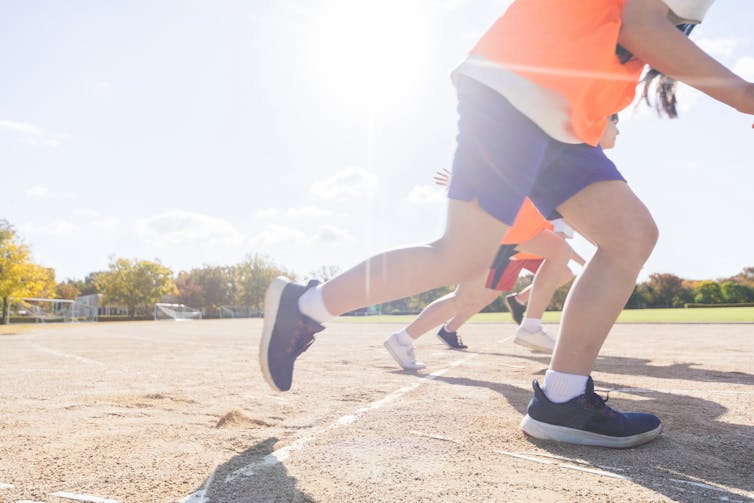Setting goals to beat previous efforts improves educational outcomes. And the gains are bigger for disadvantaged students
- Written by Andrew J. Martin, Scientia Professor and Professor of Educational Psychology, UNSW
Setting goals to try to outdo your previous best effort is known as growth goal setting or personal best goals. It is fundamentally focused on self improvement, such as investing more time or effort in a task than before or striving to achieve a higher result in the next test than the previous one.
Research over the past decade into approaches like these in education has shown it has many benefits. They include improved engagement, learning and achievement.
But it is unclear if these benefits disproportionately apply to already academically advantaged students. We wanted to know if setting goals to improve past performance affected the educational outcomes of academically disadvantaged students.
Our study, recently published in the Journal of Educational Psychology, looked at goal setting to beat previous efforts in high school students.
We found students who set goals like these were much more engaged in school than those who didn’t. And the benefits were even more positive for students in lower socioeconomic groups and students who had low levels of prior achievement.
Striving for self improvement
Growth goal setting refers to the very concrete and practical strategy of setting and striving for specific self-improvement targets.
Our interest follows a prior investigation showing that setting goals to improve was associated with increased engagement and achievement, particularly for students with attention-deficit/hyperactivity disorder (ADHD).
Read more: You can do it! A 'growth mindset' helps us learn
In our new study, we wanted to find out if striving to improve through goal setting benefited other groups of students who may be academically disadvantaged — those from low socioeconomic status backgrounds and with low prior academic achievement. Research has shown disparities in academic outcomes between these students and students from high socioeconomic backgrounds and with high prior achievement.
So we wanted to find out if setting goals to improve could narrow the gap. We also explored the role of teachers’ instruction in supporting students’ growth goal setting.
How we did our study
We drew on the New South Wales Department of Education’s annual “Tell Them from Me” student survey (provided by, and the intellectual property of, The Learning Bar).
Our study involved 61,879 high school students from 290 government schools across NSW. This represented 66% of NSW high schools. An average of 71% of students in each school responded to the survey.
 Setting growth goals is a practical strategy to try to beat your previous record.
Shutterstock
Setting growth goals is a practical strategy to try to beat your previous record.
Shutterstock
Students participated in the first term of 2018 and again in the first term of 2019. Students were in years 7-10 in 2018 and years 8-11 in 2019. Half the sample was female.
They had to answer four sets of survey questions on their:
self-improvement goals. This was assessed by asking students to rate themselves (from “strongly disagree” to “strongly agree”) on statements such as “When I do my schoolwork, I try to improve on how I’ve done before”) from a validated self-report measure
teachers’ instructional support. This was measured by students’ ratings of the extent to which their teachers gave them feedback on improving, as well as clear and organised lessons, and instructional relevance
academic engagement (perseverance, aspirations, attendance and positive homework behaviour)
personal background attributes (such as their socioeconomic levels and language background).
What we found
We found that setting self-improvement goals was associated with significant gains in all students’ perseverance, aspirations, and positive homework behaviour.
We also found teachers’ instructional practices (especially improvement-oriented feedback and instructional relevance) were important for supporting students’ growth goal setting.
The effect for perseverance was particularly striking: students who more frequently pursued growth goals were 30% more perseverant than students who were not as inclined to pursue growth goals.
Especially noteworthy was the finding that setting goals to improve on past efforts had particular benefits for academically disadvantaged students.
For students from low socioeconomic backgrounds and those with low prior achievement, such goals were associated with more aspirations to complete school and school attendance.
The positive effects on students’ engagement were over and above the effects of prior engagement. Students who pursued self-improvement by setting goals demonstrated significant improvements in aspirations and attendance from one year to the next.
Read more: Five tips to help year 12 students set better goals in the final year of school
We also found setting goals to improve minimised differences in school attendance between students from low and high socioeconomic backgrounds. In fact, low socioeconomic students who had higher growth goals were among the highest school attenders.
With regard to aspirations, setting self-improvement goals seemed to have a significant bolstering effect for students with lower prior achievement. This helped reduce the aspiration gap between low and high achieving students.
We found if low achieving students set goals to beat their previous efforts, the gap between their aspirations and the aspirations of high achieving students decreased by more than 50%.
Why setting growth goals might help
Further research is needed to fully understand our findings. One explanation may be that focusing on personal progress is motivational for academically disadvantaged students.
Read more: 'You're the best!' Your belief in your kids' academic ability can actually improve their grades
Struggling students may believe they can’t personally be academically successful if they compare themselves to others. This can lead to feelings of inferiority and disengagement. But when students are encouraged to focus on themselves and their improvement (setting goals to improve), academic success is seen as much more accessible. Exceeding one’s own prior efforts is typically seen by students as more achievable than outperforming others.
Students can learn how to set goals to improve. For a practical guide to setting self-improvement goals, see the NSW Department of Education.
Authors: Andrew J. Martin, Scientia Professor and Professor of Educational Psychology, UNSW



